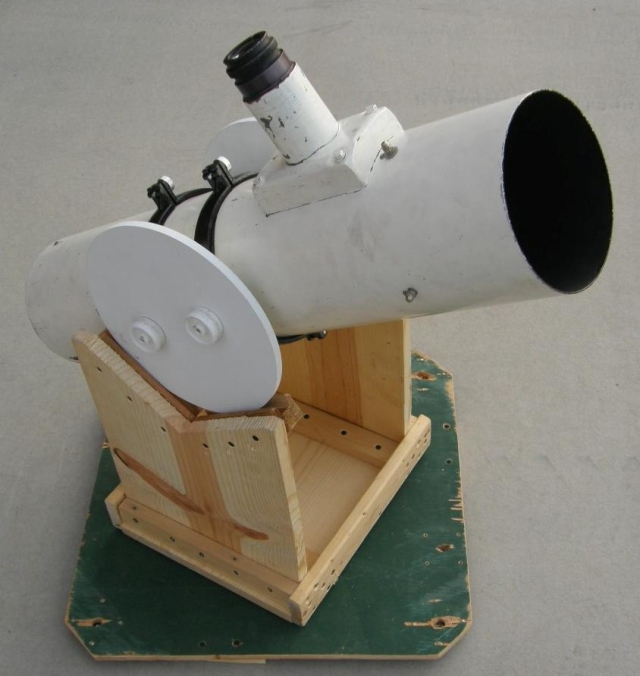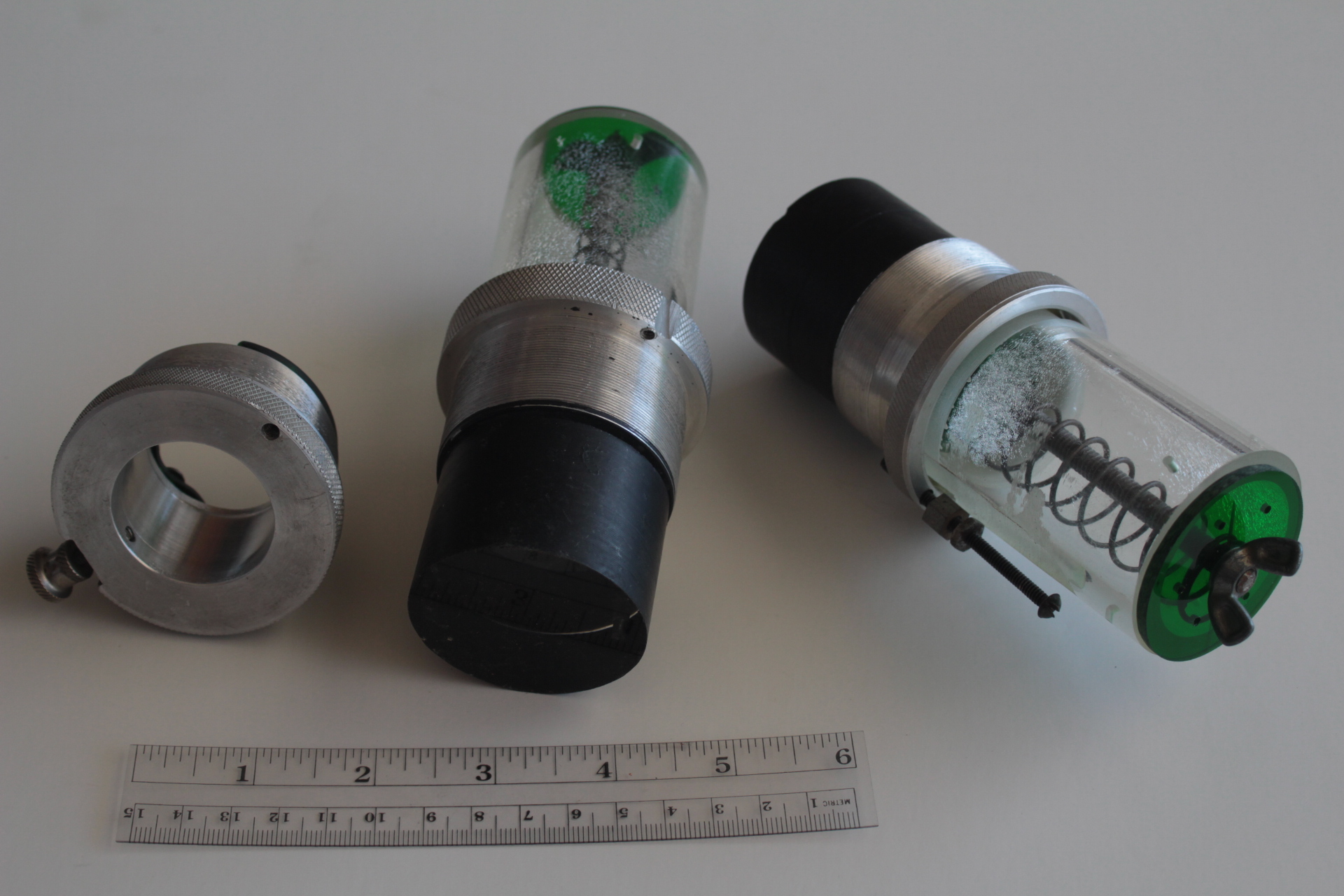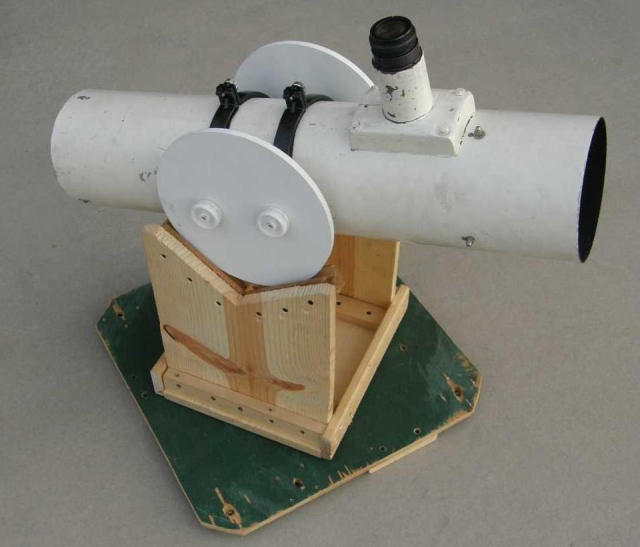Six-Inch Rich Field Telescope
Astrophotography at minus 109.3 degrees Fahrenheit
Optimized as a solid carbon dioxide cooled camera system
I made this 6-inch Newtonian telescope in the mid-1970s. By hand, I ground, polished, and figured the f/4.0 mirror. Such a short focal length telescope, when used with a long focal length wide-angle eyepiece, is called a Rich Field Telescope (RFT). A RFT produces a wide field of view at a low magnification. The telescope was made as a film-based photographic system to be carried in tandom on a larger telescope, so there was no base or mount made for this telescope. However, with such a short telescope tube, I could just tuck it under my arm or hold it in my lap for casual visual observation at that time. After retiring from the faculty of Moravian College and moving to Arizona in 2009, I made the base (shown below) for the RFT, turning it into a Dobsonian telescope. Although never intended for visual work, the Dobsonian base allowed a the telescope to be more easily used for low-magnification casual viewing of broad areas of the skies.


On the image below, notice the eyepiece itself has its own focusing ring and sits in a section of plain metal pipe. What is not apparent in the image are the internal screw threads that I cut throughout the interior of the entire length of this pipe. I made the telescope this way because the RFT system was built to support a dry-ice cold film camera, which I also made for this telescope in 1974 and 1975.

Why build such an unusual telescope system? I hope what follows in this paragraph provides a context for my decision at the time. I joined the faculty of the Physics and Earth Science Department of Moravian College in the fall of 1969. Within about 3 years I produced my first, and only, 6-inch mirror which was an f/4 because I already had the department purchase three Newtonian telescopes for student use that had 6-inch f/8 mirrors. Besides, the f/4 mirror presents greater challenges. In 1972, a patent was granted for the Celestron-Williams Cold Camera for cooling films to avoid recriprosity failure when doing astrophotography of faint objects. In the December 1973 issue of Scientific American magazine, an article with plans (see the image below for the plans) was published about constructing a homemade cold camera for similar astronomical photography. My new f/4 mirror would be perfect for this application. Although I had no experience using a metal lathe, there was one in our departmental machine shop, so a departmental colleague (Joe Powlette) taught me how to use it, and I embarked on the process of making two cold cameras and the remainder of the cold camera/telescope system. This system would be optimized for film photography of faint, large-scale celestial objects using the homemade cold cameras. All visual applications would be secondary.
I obtained a wide-field, long-focus, eyepiece with an internal focusing ring from a used military supply source and constructed the telescope and cameras to conform to the size, shape, and threads of this eyepiece. The solid metal pipe that holds the eyepiece is set farther back (toward the mirror) than usual, requiring an over-sized secondary mirror. I made two cold cameras so one could be used while the other was changing back to ambient temperatures. They are essentailly identical and are variations on the designs below.


The photo above shows the two cold cameras that I made, as well as a holder for any 1.25-inch eyepieces that I might want to use for visual work. The idea of a cold camera is to address "recriprosity failure" when photographing faint objects with long-duration exposures. If the rate of photon-induced chemical reactions within the film emulsion approaches the rate of chemical recombination, the exposure will not progress and the film becomes less sensitive. Recombination rates are higher at higher temperatures, so if the temperature is reduced during the exposure, the film will retain its original sensitivity and the image will be more truly represented on the film.
The cold camera above is supposed to operate by putting, in complete darkness, a piece of unexposed film between the spring-loaded transparent plexiglas plug and the flat base of the aluminum body of the camera, and then, also in complete darkness, threading the camera into the telescope eyepiece pipe. Dry ice (solid carbon dioxide) is then loaded in the plexiglas sleeve of the camera and this ice is compressed against the metal body of the camera by a spring-loaded piston. By letting the sublimation of the carbon dioxide cool the body of the camera, it will also cool the film that is held against it by the transparent spring-loaded Plexiglas plug. The exposure can be maintained until frost forms on the optical surface of the Plexiglas plug. At that point, the exposure is over, the remaining dry ice is removed from the piston, and the film holder is unscrewed from the eyepiece pipe and the film is removed. The process is then repeated with the second camera while the first camera returns to ambient temperatures for perhaps another iteration of the process.

Did it work? Theoretically, yes. Practically, no. There are so many ways such a system can discourage the operator and can fail because the film has to be handled in total darkness during all steps and the coolent is dangerously cold. The camera has to be prefocused (by performing a Foucault test, using a razor blade on a bright star image viewed down the threaded central piston rod hole). The film has to be cut into a disk that has the diameter of the Plexiglas plug. The disk of unexposed film has to be loaded between the aluminum camera body and the Plexiglas plug. The camera has to be installed into the telescope with the telescope entirely light-sealed. At this point in the pre-exposure process, the film is sealed inside the telescope that has light-proof covers over both ends. The now-loaded camera has to be hand-filled with dry-ice pellets and the spring-loaded piston reinstalled. After the exposure, the telescope is again covered on both ends with light-proof bags. Then the entire ice-cold camera (now at a temperature of minus 109 degrees Fahrenheit) has to be removed from the telescope, stored in a light-proof bag, and the process repeated with the second camera. After the first camera returns to ambient temperatures, the exposed film can be removed, stored in a light-proof bag or box, and that camera can be reloaded with new unexposed film, all of which must occur in light-proof bags. The cameras and/or containers with exposed film disks are subsequently opened in the photographic darkroom in total darkness and placed in light-proof photo-processing containers. Once there, the chemical processing can be done with normal room light. After photographic processing is completed, the image can be examined to see what changes should be made in the materials and procedures for the next iteration.
The contrast between the present, with the modern digital cameras and their instant displays of photographic results, and what had to be done not so long ago (at least by me), is very profound. For the non-professional, astronomy is now more available, convenient, and affordable. This progress should be celebrated.
When I retired from teaching at Moravian College in 2009, my wife and I moved to Gold Canyon, AZ. Although the Physics and Earth Science Department at that time had many telescopes and many kinds of telescopes, the only telescope that I owned, and consequently the only telescope I brought with me to AZ, was my homemade RFT/cold-camera system. It certainly is and was an unusual telescope, even for its time. It definitely is not modern, and although I didn't get success in trying my hand with cold-camera astrophotography, I still enjoy seeing this now Dob-mounted short telescope in the corner of my garage and occasionally using it in my yard to visually scan wide swaths of the dark AZ sky at low magnifications. I am certain it means more to me than it ever would to anyone else.
.




